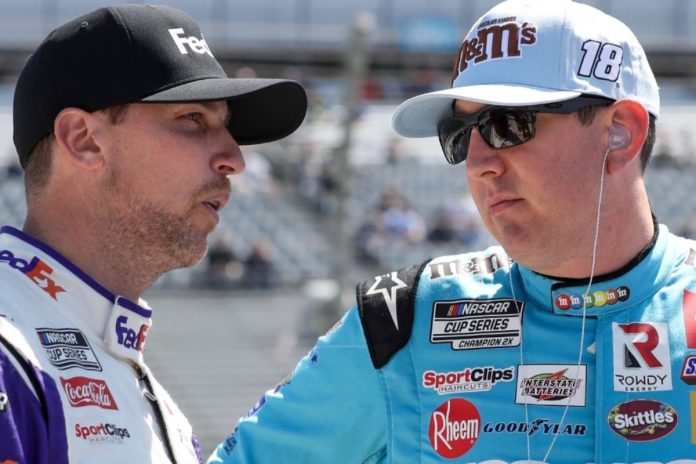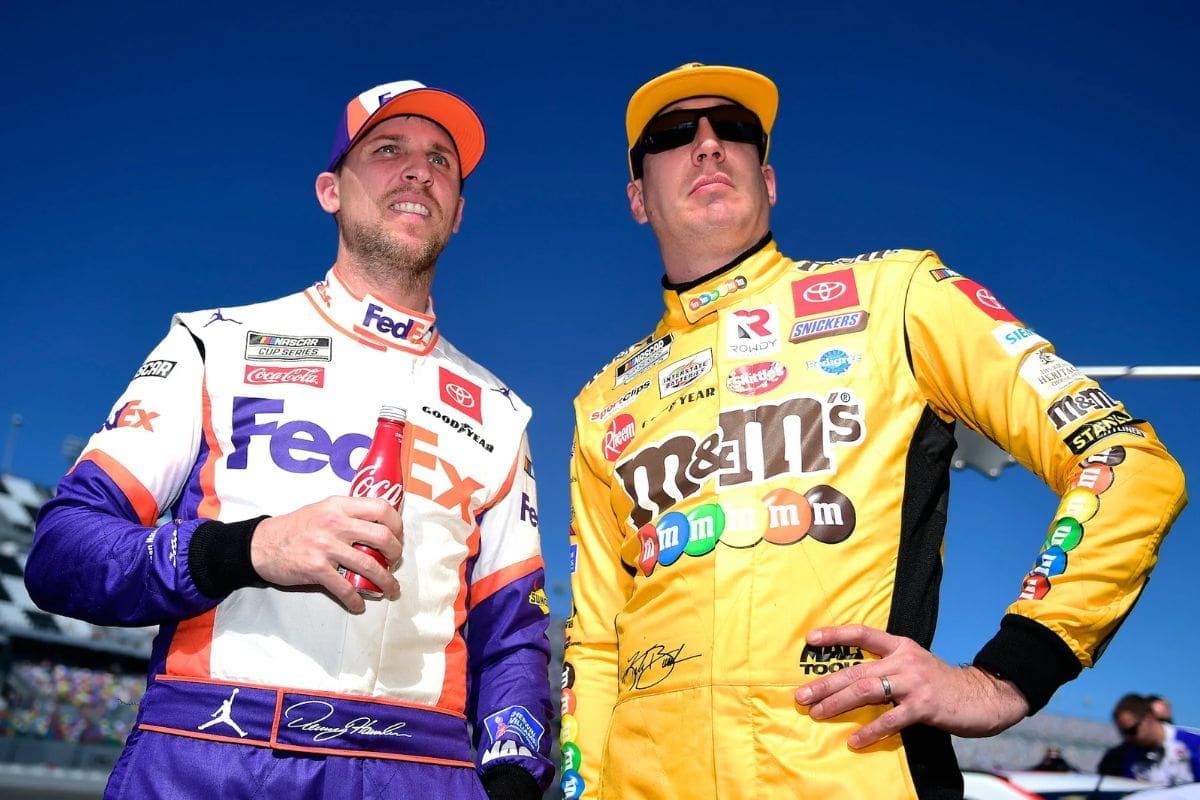Kyle Busch’s Fiery Talladega Rant: In NASCAR, the recent outburst by Kyle Busch at Talladega has not only reignited the debate around the Next-Gen car configurations but also garnered support from Denny Hamlin, further intensifying discussions on the circuit’s current dynamics. Both veterans have spotlighted what they perceive as critical oversights in vehicle design and race strategy, influenced by the latest technological impositions.
Key Takeaways
- Kyle Busch criticized the Next-Gen cars for limiting racing tactics at Talladega.
- Denny Hamlin supported Busch’s views, emphasizing the cars’ restrictive setups.
- Both drivers expressed concerns over how vehicle adjustments impact driver skill and race outcomes.
- Their comments sparked broader discussions on NASCAR’s vehicle regulations and competitive integrity.
- The incident shows ongoing debates about balancing technology, safety, and competitiveness in racing.
Richard Childress Racing’s Disappointing Outcome
Richard Childress Racing faced a disheartening outcome at the GEICO 500, as their high expectations dissolved with the #8 Chevy’s spin across the finish line, resulting in a disappointing twenty-sixth place. Entering the race with a strategy honed from previous successes, particularly the notable performance at Talladega in 2023, the team aimed to replicate or exceed past results. However, the dynamics of the race, coupled with the unpredictability of pack racing at superspeedways like Talladega, posed significant challenges.
Analyzing the race, it was evident that the #8 Chevy was positioned competitively for much of the event, demonstrating the effectiveness of the team’s preparations and vehicle setup. The car showed strong aerodynamic stability and speed in the draft, which are critical at a track where high speeds and close-quarter actions dominate the racing landscape. The driver navigated through the intense field with a blend of aggression and tactical restraint, a balance necessary for success in such environments.
Despite these positives, the final lap ‘Big One’—a common phenomenon at superspeedways where multiple cars crash due to tight, aggressive racing—ultimately ensnared the #8 Chevy. For Richard Childress Racing, this event will serve as a critical learning point, emphasizing the need for continual adaptation and perhaps, a reevaluation of risk strategies in similar future scenarios.
Kyle Busch and Denny Hamlin Express Frustrations
Kyle Busch and Denny Hamlin seasoned NASCAR competitors, openly voiced their frustrations following a series of disappointing outcomes at the GEICO 500, highlighting broader concerns with the Next-Gen car’s performance in high-stakes races. The event, typically a platform for strategy and speed, turned into a stage for grievances with the current racing setups and their impact on competition.
Despite starting in promising positions, both Busch and his teammate Austin Dillon from Richard Childress Racing fell short of expectations. This underperformance sparked a critical examination of the Next-Gen car’s adaptability to the dynamic and often unpredictable racing environment at Talladega. The frustrations articulated by both Busch and Hamlin extend beyond personal disappointment, touching on systemic issues that could affect the sport’s competitive balance and spectator appeal.
- Inconsistency and Unpredictability: Busch and Hamlin’s concerns emphasize how the Next-Gen cars may be contributing to erratic race outcomes, potentially detracting from driver skill and strategy.
- Impact on Team Dynamics: The frustrations highlight potential rifts in team coordination and strategy, exacerbated by the new car’s performance quirks.
- Broader Implications for NASCAR: Their voiced concerns serve as a critical feedback loop for NASCAR’s ongoing development and adjustments to the Next-Gen vehicles, suggesting a need for recalibration.
Kyle Busch’s Frustration and Denny Hamlin’s Agreement
Amid the environment of Talladega, frustration boiled over for veteran NASCAR driver Kyle Busch, whose vehement critique of the Next-Gen cars was echoed by his former teammate, Denny Hamlin. Busch’s disenchantment surfaced vividly post-race, manifesting in a volcanic tweet that decried the strategic stagnation enforced by the current vehicle dynamics.
Ride in line=finish where u r
TRY to race for win=finish lastI hate these 🤬 cars!!!
— Kyle Busch (@KyleBusch) April 21, 2024
Denny Hamlin aligning with Busch’s perspective, amplified this critique during the podcast ‘Actions Detrimental.’ Hamlin dissected the core issue highlighted by Busch, focusing on the tactical paralysis observable during the race’s climactic moments.
“He’s so right though,”
“And that’s the tough part about it, is that when you look at the final restart, it looks like the last lap. The two cars that controlled the outside line and the inside line were the same cars the entire last thirty laps. Because you cannot afford to get out of line. If you get out of line. It’s over.”
“The NextGen car has a tremendous amount of drag in it.”
“That’s basically how far the car can go down the straightaway.”-Hamlin
The Next-Gen Car and Superspeedway Package Debate
The Next-Gen car’s substantial drag and the contentious horsepower adjustments are central to the ongoing debate about the superspeedway racing package. Denny Hamlin’s comments shows the fundamental challenges posed by the Next-Gen car’s aerodynamic profile. The increased drag, while seemingly a safety measure, impacts the car’s performance on long straightaways, which are typical features of superspeedways. This aerodynamic feature, combined with the ongoing horsepower debate, creates a complex dynamic where drivers and teams must continuously adapt their strategies to the evolving racing environment.
The adjustments to the superspeedway package, particularly concerning horsepower, are a response to concerns about speed and safety. However, these adjustments have also influenced the racing style, pushing teams towards different tactical approaches. This has introduced a new layer of strategy to races, where the balance between speed and control becomes even more critical.
- Aerodynamic Effects: The increased drag slows down the cars, affecting overtaking and drafting strategies.
- Horsepower Constraints: Adjustments in horsepower settings are meant to level the playing field but have raised questions about fairness and competition integrity.
- Strategic Adaptations: Teams are forced to rethink strategies, focusing more on aerodynamics and less on raw power.
Evaluation of Frustrations
Given the ongoing debate around the Next-Gen car’s aerodynamics and horsepower, it is important to scrutinize the validity of Kyle Busch’s and Denny Hamlin’s frustrations with these changes at superspeedway tracks. The introduction of a common engine aimed at cost reduction has paradoxically increased horsepower, necessitating a larger spoiler to mitigate speed for safety reasons. This dynamic, as Hamlin articulates, creates a significant aerodynamic drag when attempting tactics such as overtaking, likening the experience to deploying a dragster’s parachute.
This aerodynamic impediment, while seemingly a safety measure, potentially compromises the very essence of racing—speed and strategic overtaking. Busch’s critique, therefore, centers on a perceived overcorrection by NASCAR in response to past incidents involving cars flipping over. This adjustment, intended to limit liability by slowing cars, may also be diluting the competitive nature of the race, turning strategic racing into a game of aerodynamic chance.
However, an examination of the race dynamics, evidenced by over 70 lead changes and numerous drivers (like Tyler Reddick and Harrison Burton) advancing from mid-pack to top positions, suggests a complexity in these frustrations. The data might indicate that despite the aerodynamic challenges, the field remains competitive and opportunities for strategic advancements exist, albeit under different racing conditions than some drivers prefer.
News in Brief: Kyle Busch’s Fiery Talladega Rant
The recent critiques by Kyle Busch and Denny Hamlin regarding the Next-Gen cars articulate a broader concern within the NASCAR community about the balance between technological progress and racing quality. These perspectives suggest the necessity for NASCAR’s governance to integrate driver insights into the development of racing protocols and car configurations.
Our Reader’s Queries
Q. Who is Kyle Busch’s son?
A. Brexton Locke Busch, the son of Kyle Busch, entered the world on May 18, 2015.
Q. What is Kyle Busch number?
A. In the 2024 NASCAR Cup Series season, Kyle Busch embarks on his sophomore campaign piloting the No. 8 Chevrolet Camaro ZL1 under the banner of Richard Childress Racing. This marks his 20th consecutive year of fulltime competition in NASCAR’s premier touring division. Alongside him, once more, is crew chief Randall Burnett, forming a familiar and formidable partnership as they tackle the challenges ahead.
Q. Who does Kyle Busch drive for?
A. Kyle Busch, a prominent figure in NASCAR, competes across all three national series while maintaining a full-time presence in the NASCAR Cup Series, driving for Richard Childress Racing. This notable commitment underscores Busch’s versatility and dedication to the sport at its highest level.
ALSO READ: Kyle Busch Enters Late Model Race: Eyes $40K Prize





